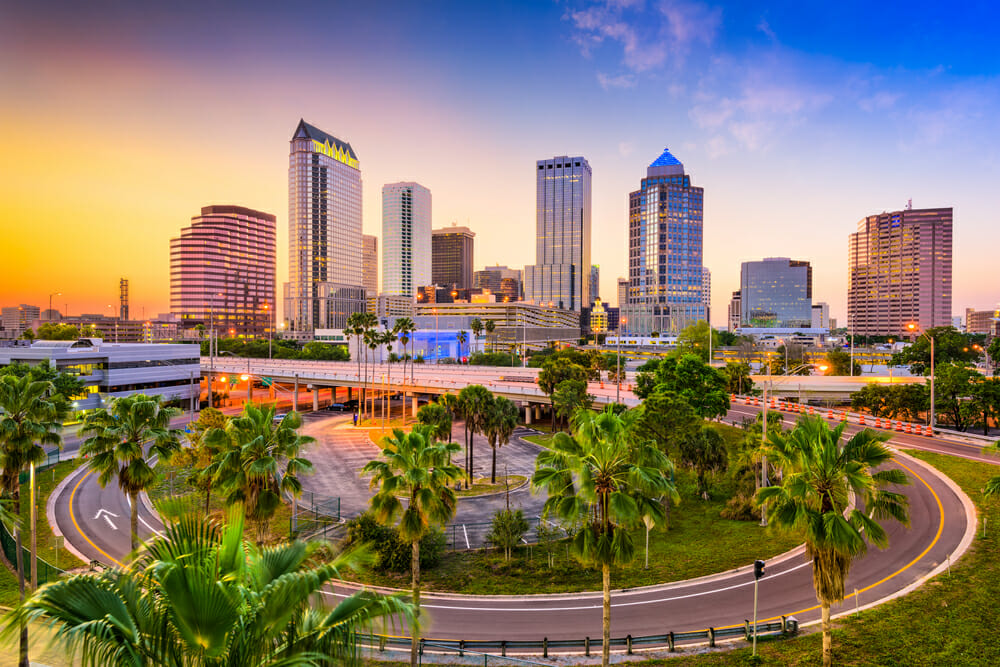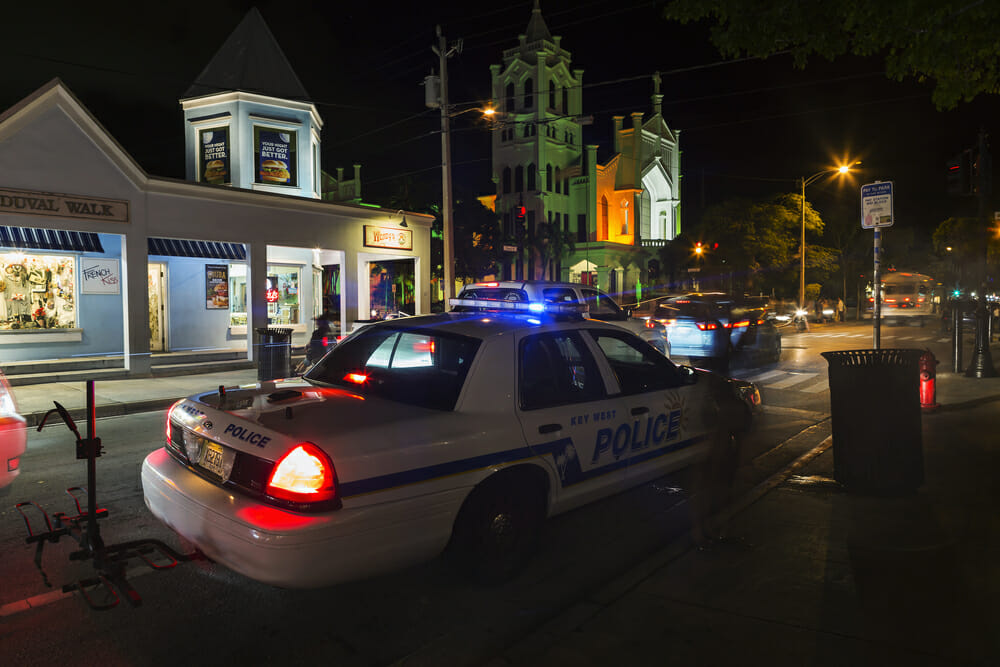
Criminal Justice in Florida
As the 3rd most populous state in the U.S. after California and Texas, Florida has a complicated and multi-faceted criminal justice system. The following sections briefly outline critical data points on Florida crime, prison, and criminal justice programs. Included are highlighted systems that work well and areas that Florida policymakers could improve.
Florida Prison Population Statistics
How many people are incarcerated in Florida? Understanding any state’s criminal justice system begins with answering this crucial question. Florida has the tenth-highest incarceration rate per capita, ahead of Montana but behind Idaho. In terms of total persons incarcerated, the state has the third most prisoners, ahead of Georgia but behind California. Most offenders in Florida serve sentences in state prisons, though about a third of incarcerated individuals are locked up in local jails.1
Of concern, though the state’s jail population has declined since 1993, the prison population has continued to go up, with just slight decreases in recent years. When a jail population declines but a prison population soars, that suggests a larger number of Floridians who were accused of crimes and were being held short-term in jail are now being convicted and sentenced to long prison terms. This scenario has played out even as Florida’s overall crime rates have receded, indicating that a higher percentage of the accused now face harsh prison sentences.

According to 2019 National Institute of Corrections data, Florida has 87 jails in 67 counties.2 The state’s jail population was 64,710 in 2019. Florida also has 143 prisons that hold some 96,009 individuals. Florida also has 204,159 people under probation and 4,349 people under parole. The State of Florida employs some 25,154 persons in its Department of Corrections, which has an annual budget of $2.6 billion. Florida’s Department of Corrections is the state’s seventh costliest budget item.3
Florida also has eight stand-alone federal prisons and four prison camps. The Southeast Regional Office manages Florida’s federal prisons.4 Florida is also becoming more involved with private prisons, with one piece of investigative journalism indicating that Florida’s private prison population has grown significantly across seven facilities in just a few years.5 While private prison systems do have their proponents, it is of concern to some that about 13% of Florida’s incarcerated now serve time in private prisons, a 176% increase since 2000.6
In a state with such a large prison population, the obvious question is, what are the biggest prisons in Florida? The Union Correctional Institution, located in Raiford, is the largest Florida prison with a population capacity of over 2,000 inmates.7
Crime and Recidivism Rates in Florida
Florida’s incarceration rate is 444 per 100,000 population. The state’s violent crime rate is 378 per 100,000, its property crime rate is 2,146 per 100,000, its probation rate is 1,175 per 100,000, and its parole rate is 25 per 100,000.
One of the best metrics by which to measure the success of a state’s criminal justice system is its recidivism rate. According to the Bureau of Justice Assistance, Florida’s recidivism rate is about 25%.8 Further, according to a Florida Department of Corrections report, Florida’s recidivism rate has gradually declined since 2008, from 27.7% to 24.1% in the state’s most recent findings.9
The FDC determined that the three major factors influencing the likelihood of recidivism were whether or not inmates had a term of supervision following release, whether or not the person had prior prison sentences, and whether or not the person was affiliated with gang membership. Post-prison release supervision, prior sentences, and gang affiliation were all associated with a higher likelihood of recidivism.
Criminal Reform in Florida
 Despite the state’s high prison population, some good news is that criminal rehabilitation for offenders in Florida seems to be working, as indicated in the above section regarding the state’s declining recidivism rates. Further, the Florida Department of Law Enforcement published a bulletin announcing crime rates had fallen for a record 50 straight years. In the words of the bulletin’s author, “The report shows Florida’s total crime volume dropped 14.1 percent, or 76,523 fewer reported index crimes, compared to 2019. Overall, property crimes dropped by 17 percent in this report, or 78,373 crimes. Meanwhile, violent crime edged up by 2.3 percent, or 1,850 crimes. The index crimes of rape, robbery, burglary, larceny and motor vehicle theft crimes were down, while murder and aggravated assault increased. Domestic violence murder was down in 2020, while stalking increased.” Crime rates are declining, and released inmates are slightly less likely to re-offend.10
Despite the state’s high prison population, some good news is that criminal rehabilitation for offenders in Florida seems to be working, as indicated in the above section regarding the state’s declining recidivism rates. Further, the Florida Department of Law Enforcement published a bulletin announcing crime rates had fallen for a record 50 straight years. In the words of the bulletin’s author, “The report shows Florida’s total crime volume dropped 14.1 percent, or 76,523 fewer reported index crimes, compared to 2019. Overall, property crimes dropped by 17 percent in this report, or 78,373 crimes. Meanwhile, violent crime edged up by 2.3 percent, or 1,850 crimes. The index crimes of rape, robbery, burglary, larceny and motor vehicle theft crimes were down, while murder and aggravated assault increased. Domestic violence murder was down in 2020, while stalking increased.” Crime rates are declining, and released inmates are slightly less likely to re-offend.10
“The report shows Florida’s total crime volume dropped 14.1 percent, or 76,523 fewer reported index crimes, compared to 2019. Overall, property crimes dropped by 17 percent in this report, or 78,373 crimes. Meanwhile, violent crime edged up by 2.3 percent, or 1,850 crimes. The index crimes of rape, robbery, burglary, larceny and motor vehicle theft crimes were down, while murder and aggravated assault increased. Domestic violence murder was down in 2020, while stalking increased.”
The criminal justice system in Florida works on a scoresheet program to encourage criminal reform while leaving incarceration as a last option. The scoresheet is complicated, but calculations to determine how many points an offender has against them will determine whether or not they go to jail or prison. The Florida Department of Corrections prepared a manual that helps interested parties determine how the scoresheet program works.11
Florida also implements mandatory minimum sentencing laws for drug crimes, sex crimes, and gun crimes. Critics of this type of criminal reform say it is partially responsible for an increasing prison population even as crime rates have decreased. Proponents of such sentencing laws indicate the laws streamline the criminal justice process and provide a universal metric of justice for all offenders.12
Alternatives to Incarceration in Florida
Florida invests in “community control,” i.e., community intervention in an offender’s life instead of incarceration. Community control programs include work release, probation, house arrest, electronic monitoring, community service, mandatory drug or alcohol rehab, or another type of alternative sentence.
Alternatives to prison should be expanded in Florida, especially for offenders who have committed nonviolent crimes. There is also a need for educational programs inside prisons in Florida. There is a direct correlation between crime and overall educational attainment, as shown in a story published in the Economic Journal. Further, inmates need to be helped to understand the underlying issues that led them to commit a crime in the first place. Such educational programs could empower incarcerated individuals to learn important life skills and build up healthy coping mechanisms that might help them avoid committing crimes in the future.13
Policymakers could expand rehabilitation programs inside Florida prisons, which could help reduce sentences, further reduce recidivism, and help offenders improve their lives and the lives of their families, friends, loved ones, and community members.
Sources:
- BJS. “Prisoners in 2020 – Statistical Tables.” Bureau of Justice Statistics, 2020. bjs.ojp.gov
- NCIC. “Florida 2019.” National Institute of Corrections, 2019. nicic.gov
- UPI. “Project Florida.” Urban Policy Institute, 2022. urban.org
- BOP. “Southeast Regional Office.” Federal Bureau of Prisons, 2022. bop.gov
- Jacksonville “New contracts give private prison giant nearly 80 percent of Florida’s private prison market.” The Florida Times-Union, 2013. jacksonville.com
- Sentencing Project. “Private Prisons in the United States.” The Sentencing Project, 2020. sentencingproject.org
- FDC. “Union Correctional Institution.” Florida Department of Corrections, 2022. dc.state.fl.us
- BJA. “Florida.” Bureau of Justice Assistance, 2014. bjafactsheets.iir.com
- FDC. “Florida Prison Recidivism Report: Releases from 2008 to 2019.” Florida Department of Corrections, 2021. dc.state.fl.us
- FDLE. “Florida crime rate drops for record 50th straight year.” Florida Department of Law Enforcement, 2020. fdle.state.fl.us
- FDC. “Criminal Punishment Code Scoresheet Preparation Manual.” Florida Department of Corrections, 2019. dc.state.fl.us
- DOJ. “Mandatory Minimum Sentencing in Florida: Past Trends and Future Implications.” Office of Justice Programs, 1991. ojp.gov
- WOL. “The Effect of Education on Criminal Convictions and Incarceration: Causal Evidence from Micro-data.” Wiley Online Library, 2014. onlinelibrary.wilely.com
Related Articles
What Is the Scope of Private Prisons in the U.S.?
In 2001, the Federal Bureau of Justice Assistance authored a report analyzing then-emergent issues regarding private prisons in the United States. According to the authors...
Read more >>
A Lifer Becomes a Criminon Facilitator and Mentor
Thank you for acknowledging me as a Criminon Facilitator. I take great pride in being a part of the Criminon organization. I've been incarcerated since...
Read more >>
Journey from Hate and Violence to Hope and Faith
My success story starts when I took and completed the Criminon course The Way to Happiness. I’ve been incarcerated in prison since I was 18...
Read more >>
An Inmate’s Transformation in a Florida Prison
I was a professional criminal all my life: a drug dealer, an armed robber, rip-off artist, con artist, thief and liar. And I was completely...
Read more >>





